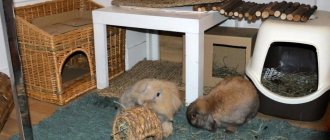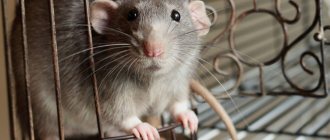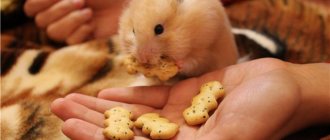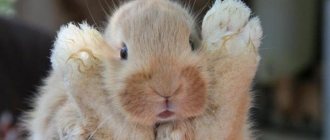Not all rabbit owners know that they can actually be trained to do their business in a litter box. But those who have heard about this ask how to train a rabbit to use a litter box in a cage or apartment? To do this, you will need to wait until the rabbit grows up, and also purchase all the necessary accessories.
Rodents have the same requirements as cats: they will need a tray of suitable sizes and the right filler that will suit the animal well. However, the most important thing is the owner’s patience. It takes rabbits a long time to understand what is required of them, but the result can be expected from any animal, regardless of breed or gender.
At what age should a rabbit be litter trained?
It is much easier to train an adult rabbit to go to the litter box than a small animal.
This is all due to the fact that rabbits are not very smart. In general, you can accustom a rabbit to a tray in a cage from three or four months. Advice! The first training begins when the animal has already been living separately from its mother for 40-50 days.
Many breeders consider this moment optimal.
This is all due to the fact that the animal has become quite smart, but has not yet developed strong habits due to its young age.
How to choose what you need?
Before you start working with your rabbit, you need to choose a tray and filler. A litter box is a particularly important accessory that ensures the success of your pet's training. Let's figure out what, according to reviews from rabbit breeders, you should choose to accustom your rabbit to a special tray in the apartment.
Tray
There are two types of trays for large rodents. Corner ones are installed in cages that are not the most spacious, while rectangular ones can be placed in rabbit pens and spacious cages. It is much easier to accustom a decorative rabbit to them: there is enough space for the animal to carry out its business simply.
Regardless of the shape, the tray should have a removable grid. It will make it easy to clean the container from urine and feces. The grille must be either plastic or metal. Some breeders believe that metal should be used so that the rodent cannot damage the surface in any way.
Some breeders save money and use homemade trays. They are made from large food containers with small sides. But it’s better not to skimp and buy a good model. This is due to the fact that purchased trays are made of thick plastic, which can withstand attacks from rabbits. And their sizes are guaranteed to fit, so animals are less likely to ignore them.
Filler
In large cities there are pet stores that sell special litter for rabbits. They are made from hypoallergenic, non-toxic material that easily absorbs all liquids and unpleasant odors. But in small settlements it is difficult to buy litter for large rodents.
Therefore, some people make filler at home. It is created from finely chopped soft paper - but you need to be careful here, because the paint can be toxic to rodents.
Reference! Usually, for these purposes, unpainted paper, scrapped or simply surplus, is cut.
Another option is sawdust. This type of filler is especially easy to obtain if you have a fireplace or if you live in a rural area. Any type of wood is suitable, except conifers. All because of concentrated essential oils, which repel the rabbit and prevent him from using the toilet.
In general, sawdust is rarely used because it does not completely absorb odors. Therefore, they have to be changed more often than a full-fledged litter for a rabbit tray.
But cat granules, which are easy to buy even in a regular store, are prohibited for animals. They are treated with special compounds to eliminate odor. This can provoke allergies in eared animals. Moreover, rabbits may accidentally ingest the pellets in their feces, become poisoned, or even die.
Sand litter is also prohibited for rabbits. Yes, their close relatives, chinchillas, love to dig in the sand. But it will be difficult for lagomorphs to go to the toilet with sand; they will simply dig up everything and scatter grains of sand throughout the cage. In general, investing in the beauty of a rabbit cage and its surroundings is stupid. Same with the tray: convenience is much more important than the aesthetic component.
Creating optimal conditions
It's worth remembering the following:
- most rodents spend a lot of time in the toilet
- Rabbit urine has a very strong smell
- rabbits eat their droppings
How to choose a filler?
It is necessary to choose a safe filler based on paper, unprocessed aspen sawdust, special wood pellets, and alfalfa-based oat grain. Cat litter is not suitable for this purpose.
Important! You can lay newspaper or film under the filler, then cleaning the tray will be faster. Before using the newspaper, it is important to make sure that the ink does not leave stains on the rabbit's fur, as such marks can be toxic.
Pressed pallets are a good option: they are non-toxic, easy to use, and if a rabbit eats them, they will also not cause any harm. Another suitable type of filler is citrus-based.
Not recommended:
- Use sawdust containing oils (pine, cedar, etc.) as a filler, as fumes can irritate the rabbit's lungs.
- Fill the tray with sand (this sedimentary rock is also bad for the animal's lungs).
- Cover the tray with torn newspapers - such a mass will quickly get wet and become unusable.
- Use clay as a filler: the rabbit may start eating it and clog the intestines. Clay litter is very dusty and can cause pneumonia in your rabbit.
- Earth is also not suitable as a filler, since animals like to dig in the ground, which can result in a lot of dust.
- Use untreated sawdust as a basis - they absorb moisture much worse, and the dust from them will prevent your pet from breathing freely.
- You should not use litters made from corn, as the rabbit will prefer to eat them and quickly gain weight.
- Deodorizing crystals can be toxic.
- Clumping litters accumulate inside the rabbit's digestive and respiratory tracts, causing problems and leading to the death of the animal.
Important! Rabbits, unlike cats, do not bury their waste, so there is no need to add a thick layer of litter.
Where is the best place to put the tray?
In the wild, rabbits are fairly clean animals. Their instincts prevent them from going to the toilet where they live, eat and rest. Therefore, serious problems rarely arise with litter box training. But in order to train a rabbit to use the toilet outside or inside the cage, you need to choose the right place.
You need to choose the corner in which the rabbit most often relieves itself. And it doesn’t matter whether it’s a corner of an apartment or a corner of the cage in which the animal lives.
Keeping it clean
- To eliminate odor and disinfect the space, it is recommended to use white or apple cider vinegar diluted in water.
- The tray must be cleaned frequently so that the animal gets used to the new place faster. Used areas of the filler must be removed every day, and general cleaning must be done at least once a week.
- Strong chemicals are not suitable for cleaning as they have a strong odor that will be unpleasant to the animal. Soap is also unsuitable for use. The solution is to use a product containing chlorine; you can also use soda and mustard for washing.
- You can also use special cleaning agents that are harmless to small rodents; they are sold at pet stores.
How to litter train a rabbit? Step-by-step instruction
In order for the animal to learn to defecate in one place, you need to follow simple instructions. Usually these exercises are carried out with a rabbit up to a year old. At this age, the animal copes with intellectual stress and lends itself well to training. The sequence of actions of the owner is as follows:
- First, install the tray where the rabbit often visits: in a cage or in the area where he walks around the house. The animal must get used to the smell of the filler and the appearance of the accessory. Some even install a toilet next to the food bowl, so the pet’s positive association will be established faster;
- Then put the animal's feces into the litter so that it smells a characteristic smell. This way the rabbit will figure out what the toilet is for. In this case, you need to wash with vinegar the places where the odors of urine and feces may come from. Then the pet will not associate old places with possible places to defecate;
- If the animal still does not understand what is required of it, you need to transplant it, which has begun to do its business, into a tray. In this case, you need to pronounce a command, preferably a simple one - like “Tray” or “To the toilet”. Over time, the rodent will begin to associate the owner’s words with the need to run to the litter box. The voice should be firm, but not angry.
When the animal uses the tray correctly for the first time, it is necessary to reinforce its action with positive reinforcement. For example, you can give your rabbit a treat that he likes. If your pet loves tactile contact, be sure to pet him and praise him in a soft voice.
If you can’t teach your rabbit to go to the toilet in the right place, you’ll have to use a trick.
Interesting! You need to install several more trays in the cage or in the space where the rabbit lives.
Then he will eventually begin to go to one of the proposed toilets. The rest, which the rabbit will continue to ignore, should be removed.
Possible problems
The rules for accustoming an animal to a tray are quite simple. But even when implementing them and obtaining the desired result, some problems may arise.
Some rabbits suddenly begin to rest in the tray rather than relieve themselves in it. And the other begins to completely ignore the accessory. Let's figure out how to properly get rid of both the first and second troubles.
Filler selection
When choosing a filler, you should take into account that rabbits are extremely curious: they can try anything that interests them. That is why the material must be, first of all, safe.
Did you know? Rabbits are often characters in children's books - these include "Alice in Wonderland", and "Winnie the Pooh", and "Peter Rabbit", as well as many fairy tales from around the world
The Frenchwoman Genevieve Hurie did not ignore the fluffy one either. She began writing stories about a rabbit family back in 1987; to date, more than twenty stories have been created, and some stories have been filmed.
Granular form
Granulated sawdust is safe in case of accidental ingestion and absorbs odor well. By absorbing feces, the granules swell but do not spread, which makes them easy to clean. In place of the removed lump, fresh mixture is poured, so the consumption is small. The granules have a woody smell, which does not scare away or alarm the animal.
Sawdust and paper
Sawdust and paper can be used as filler, but in this case the tray will require more frequent care and washing. The materials do not absorb “aromas” and moisture very well, and they creep apart.
You will probably be interested to know how many years rabbits of different breeds live.
What to do if your rabbit falls asleep in the litter tray?
If the rabbit prefers not to sleep on the bedding, but to lie down in the tray, this may indicate that the cage is dirty. I need to clean it more often.
The animal understands that the tray is constantly being cleaned, so it chooses it for rest. To get rid of the problem, you need to quickly sort out the litter and add new straw.
Then the animal will begin to go to the tray again and begin to rest in a new place, cleared of scraps of fur and other traces of vital activity.
Additional Tips
Some more useful tips:
- Do not hit the animal if it defecates in the wrong place.
- It is easier to litter train an older rabbit than a baby.
- Training will be easier if a clear schedule of all procedures is drawn up. You need to stick to it every day.
- Good fillers: sawdust, shavings, scraps of newspaper, straw, oats.
- Change the litter daily.
- The cage should be selected in such a size that the pot fits in it.
- To prevent the rabbit from having the desire to mark territory, let him feel like the owner of his house.
Find out how to keep decorative rabbits in an apartment.
As you can see, potty training a long-eared dog is a necessary and easy task. With patience and perseverance, a positive result can be achieved after a week of training.
Why did the rabbit stop going to the litter box?
There are several reasons why a rabbit suddenly refuses to go to the toilet. First, if he reaches four months of age, he may begin to mark his territory. There is no way to regulate this problem before the onset of puberty. This is because early spaying or castration can seriously affect the health of your long-eared pet.
The second reason is the appearance of a new animal in the house and stress provoked by some other changes in the environment. Rodents are quite jealous of “their territory,” so they can use marks to show that they are its rightful owners.
Reference! It is useless to scold and punish the rabbit for this.
He will simply stop trusting the owner. It is better to remove the cause of stress and repeat the training process according to the previous instructions. The results will appear quickly.
Difficulties in training and ways to solve them
Below are the most common problems that arise during training.
walks by
This is probably due to the container leaking. You need to carefully check its bottom. If this is indeed the case, then you can place a tray down.
The reason may also lie in the walls being too low. You will have to change the toilet or make the layer of filler thinner.
If the rabbit continues to miss, the only solution is to place a rubber mat next to the tray. This will simplify the cleaning process.
Sleeping inside
This behavior of the pet means that he is more comfortable in the tray. In order for the rabbit to sleep in the right place, you need to reconsider the features of its arrangement. The bedroom should be warm, with plenty of hay, closed from prying eyes.
Throws out contents
You can try changing the filler. If this does not help, the only option is to purchase a tray with completely closed walls.
Rabbit eats litter
Many owners of furry animals are wondering if the rabbit has litter for the toilet, what to do. It is recommended to show the animal to a veterinarian, because... This phenomenon is associated with serious reasons.
Why does he eat inedible things?
Experts identify several reasons:
- the rabbit is not allowed to eat its own feces;
- the animal has intestinal worms;
- the pet has dystrophy or malnutrition;
- the rabbit does not have enough fluid in its diet;
- the animal is poorly and insufficiently fed;
- The pet is in some pain.
The rabbit must be allowed to eat its own feces. They contain many nutrients. In this way, animals make up for their deficiency.











